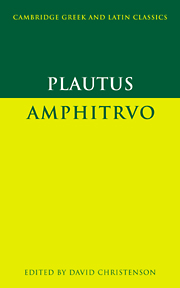The play’s thing
from Introduction
Published online by Cambridge University Press: 05 March 2013
Summary
Theme, structure, and movement
Am. is one of three extant Plautine doubles-comedies. It is immediately distinguishable from its congeners (Bac., Men.) by the mythical dimension of its plot and the fact that this plot calls for impersonation rather than identical twins. But more significant than these superficial distinctions in defining the uniqueness of Am. is its self-conscious development of the theme of gemination. A primary impulse of any comedy featuring at least one pair of precise doubles is to create as many permutations of characters and situations as possible, so as to exploit every opportunity for humorous confusion. Typically, a climactic scene brings the doubles face to face, whereby the issue of identity is resolved. To examine how Plautus articulates this conventional framework of doubles-comedy in Am., we must first catalogue the seventeen scenes that follow the prologue:
(Mercury‘s prologue (1-152))
Sosia, Mercury (153-462)
Mercury (463-98)
Jupiter, Alcmena, Mercury (499-550)
Amphitryon, Sosia (551-632)
Alcmena, Amphitryon, Sosia (633-860)
Jupiter (861-81)
Alcmena, Jupiter (882-955)
Sosia, Jupiter, Alcmena (956-83)
Mercury (984-1008)
Amphitryon (1009-20)
Mercury, Amphitryon (1021-fr. 6)
Alcmena, Amphitryon (frs. 7-10)
Amphitryon, Blepharo, Sosia (frs. 11-14)
Jupiter, Amphitryon, Blepharo (fr. 15-1052)
Bromia, Amphitryon (1053-1130)
]up er Amphitryon 1131-43)
Amphitryon 1144-6)
- Type
- Chapter
- Information
- Plautus: Amphitruo , pp. 13 - 45Publisher: Cambridge University PressPrint publication year: 2000

